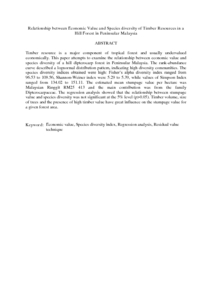Citation
Abd. Ghani, Awang Noor and Ibrahim, Faridah Hanum and Tuan Ibrahim, Tuan Marina
(2008)
Relationship between Economic Value and Species diversity of Timber Resources in a Hill Forest in Peninsular Malaysia.
Journal of Sustainable Development, 1 (2).
pp. 17-26.
ISSN 1913-9063
Abstract
Timber resource is a major component of tropical forest and usually undervalued economically. This paper attempts to
examine the relationship between economic value and species diversity of a hill dipterocarp forest in Peninsular
Malaysia. The rank-abundance curve described a lognormal distribution pattern, indicating high diversity communities.
The species diversity indices obtained were high: Fisher’s alpha diversity index ranged from 96.53 to 109.56,
Shannon-Weiner index were 5.29 to 5.39, while values of Simpson Index ranged from 134.02 to 151.11. The estimated
mean stumpage value per hectare was Malaysian Ringgit RM25 413 and the main contribution was from the family
Dipterocarpaceae. The regression analysis showed that the relationship between stumpage value and species diversity
was not significant at the 5% level (p>0.05). Timber volume, size of trees and the presence of high timber value have
great influence on the stumpage value for a given forest area.
Download File
![[img]](http://psasir.upm.edu.my/7487/1.hassmallThumbnailVersion/Relationship%20between%20Economic%20Value%20and%20Species%20diversity%20of%20Timber%20Resources%20in%20a%20Hill%20Forest%20in%20Peninsular%20Malaysia.pdf)  Preview |
|
PDF (Abstract)
Relationship between Economic Value and Species diversity of Timber Resources in a Hill Forest in Peninsular Malaysia.pdf
Download (186kB)
| Preview
|
|
Additional Metadata
Actions (login required)
 |
View Item |

